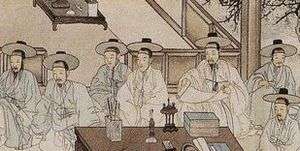Korean jade carving
 |
| Part of a series on the |
| Culture of Korea |
|---|
| History |
|
Music and performing arts |
|
|
Monuments |
|
National symbols of Korea |
|

The tradition of Korean jade carving dates back to neolithic finds along the Namgang river basin in Gyeongju. Jade rings and accessories were worn by the higher classes of society, especially women, from the three kingdoms period and reached their peak in the Joseon dynasty, the golden age of jadework. Korean jadework often includes buddhist motifs, cicadas, and peanut-shaped good luck talismans on the small scale, as well as larger-scale architectural pieces.
Contemporary jade masters
Amongst the most famous is Jang Ju-won who has been designated Important Intangible cultural heritage No. 100. Jang is known for his refinement, and largely self-taught has recovered jadework for future generations.
Local Markets
In the local markets there now exists a wide variety of jade carvings and jewelry available for purchase. These items are much less costly than their Chinese counterparts.